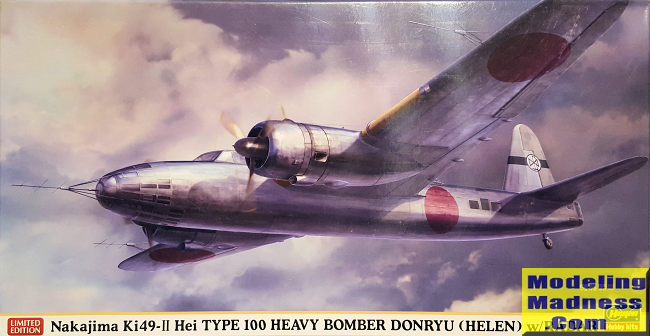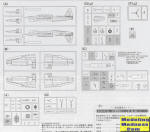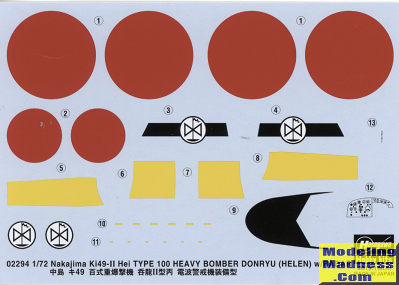
| KIT #: | 02294 |
| PRICE: | 3600 yen SRP |
| DECALS: | One option |
| REVIEWER: | Scott Van Aken |
| NOTES: | 2019 Limited Edition. |

| HISTORY |
Going operational from autumn 1941, the Ki-49 first saw service in China. After the outbreak of the Pacific War it was also active in the New Guinea area and in raids on Australia. Like the prototype, these early versions were armed with five 7.7 mm (0.303 in) machine guns and one 20 mm cannon. Combat experience in China and New Guinea showed the Donryu to be underpowered, with bomb capacity and speed suffering as a result. Thus, in the spring of 1942 an up-engined version was produced, fitted with more powerful Ha-109 engines and this became the production Army Type 100 Heavy Bomber Model 2 or Ki-49-IIa. The Model 2 also introduced improved armor and self-sealing fuel tanks and was followed by the Ki-49-IIb in which 12.7mm (0.5 in) Ho-103 machine guns replaced three of the 7.7 mm (0.303 in) Type 89 machine guns.
In spite of these improvements, losses continued to mount as the quantity and quality of fighter opposition rose. An attempt was made to stop the rot in early 1943 by further up-engining the type. This petered out owing to development difficulties with the 1,805 kW (2,420 hp) Nakajima Ha-117 engines and the Ki-49-III never entered production with only six prototypes being built.
In the face of its increasing vulnerability to opposing fighter aircraft while performing its intended role, the Ki-49 was used in other roles towards the end of the Pacific War, including ASW patrol, troop transport and as a kamikaze. After 819 aircraft had been completed, production ended in December 1944.
| THE KIT |
 For
whatever reason, the Ki-49 does not seem to be a very popular subject for
modelers. I've only seen one built in all these years and I often wonder why.
Perhaps it is the plethora of tiny windows that have scared away modelers once
they realize what they've gotten themselves into. It is certainly not lacking in
nice surface detailing and it does offer fairly standard detailing for your
average 1/72 kit.
For
whatever reason, the Ki-49 does not seem to be a very popular subject for
modelers. I've only seen one built in all these years and I often wonder why.
Perhaps it is the plethora of tiny windows that have scared away modelers once
they realize what they've gotten themselves into. It is certainly not lacking in
nice surface detailing and it does offer fairly standard detailing for your
average 1/72 kit.
The cockpit section s fairly basic with a pair of seats, control wheel assembly and an instrument panel. The bomb bay attaches to the interior floor and there is an additional small floor with a bulkhead for the tail gun position. As mentioned, there are windows galore and several of the ones in the rear fuselage need to be attached from the outside. Some holes need to be drilled as well to do this variant.
Engine nacelles are left and right halves that incorporate the gear well. I think this is a step backwards as it leaves a seam at the front of the engine opening that is always difficult to deal with, especially as the engine needs to be installed prior to closing the nacelle halves. Add to this that the upper intake is molded in with the nacelle instead of being separate. Lower intake is separate so why not the upper as well? The props will be held in place by a polycap that fits behind the gearbox.
Since this is a mid wing aircraft, the wings are in upper and lower sections for both sides. If doing the kit version with radar, you need to open holes for mounting it. The wings and tailplanes are then slotted in place. Frankly, I'd wait until after attaching the cockpit, nose and tail clear bits to make it easier to mask and deal with any seams. Since this is a radar trainer, the bomb bay will be empty so the doors are glued in the closed position.
The instructions then have you assemble and attach the
landing gear and doors. I'd leave this step off until after painting. Then we
add all the clear pieces and there are several of them. Note that this plane is
unarmed so we will not have added all the guns. We will need to attach all the
radar bits which
 are on a
separate sprue. The wing ones will have the mounts over the wing hinomarus so
keep that in mind when building.
are on a
separate sprue. The wing ones will have the mounts over the wing hinomarus so
keep that in mind when building.
Instructions are standard fare for Hasegawa and there is a single markings option, for a plane with the Army Air Communications School in 1944. The plane is overall unpainted metal with grey-green control surfaces and black anti-glare areas on the inside of the engine nacelles and in front of the cockpit.This latter item is provided as a decal, which is a nice touch. Also included on the sheet is an instrument decal and the yellow wing ID bands. As this is a relatively new release, the decals are the newer type with actual white whites and should be fairly thin as well.
| CONCLUSIONS |
As mentioned, not exactly a kit for which many are clamoring, but it does look as if it will build into a very nice model and was one that Hasegawa initially released in the 1990s when they did a spate of twin engine aircraft. I'm often left wondering why they didn't do a Ki-21 as there is certainly a demand for one. Perhaps in the future.
| REFERENCES |
https://en.wikipedia.org/wiki/Nakajima_Ki-49
April 2021
Copyright ModelingMadness.com. All rights reserved. No reproduction
without express permission.
If you would like your product reviewed fairly and fairly quickly, please
contact
the editor or see other details in the
Note to
Contributors. Back to the Main Page
Back to the Review
Index Page
Back to the Previews Index Page